How to avoid executing malware via emails like "TNT Email Virus"
Phishing/ScamAlso Known As: TNT spam
Get free scan and check if your device is infected.
Remove it nowTo use full-featured product, you have to purchase a license for Combo Cleaner. Seven days free trial available. Combo Cleaner is owned and operated by RCS LT, the parent company of PCRisk.com.
What is "TNT Email Virus"?
"TNT Email Virus" is one of many spam email campaigns that is used by scammers to trick people (email recipients) into opening malicious attachments. Cyber criminals use email attachments (or web links) to proliferate high-risk viruses - in this case, the LokiBot virus.
The main purpose of these spam campaigns is to trick people into opening the link (and downloading the attachment) by presenting it as a legitimate message. Some examples of other similar email campaigns include Thanksgiving Email Virus, CitiBank Email Virus, and IRS Online Email Virus.
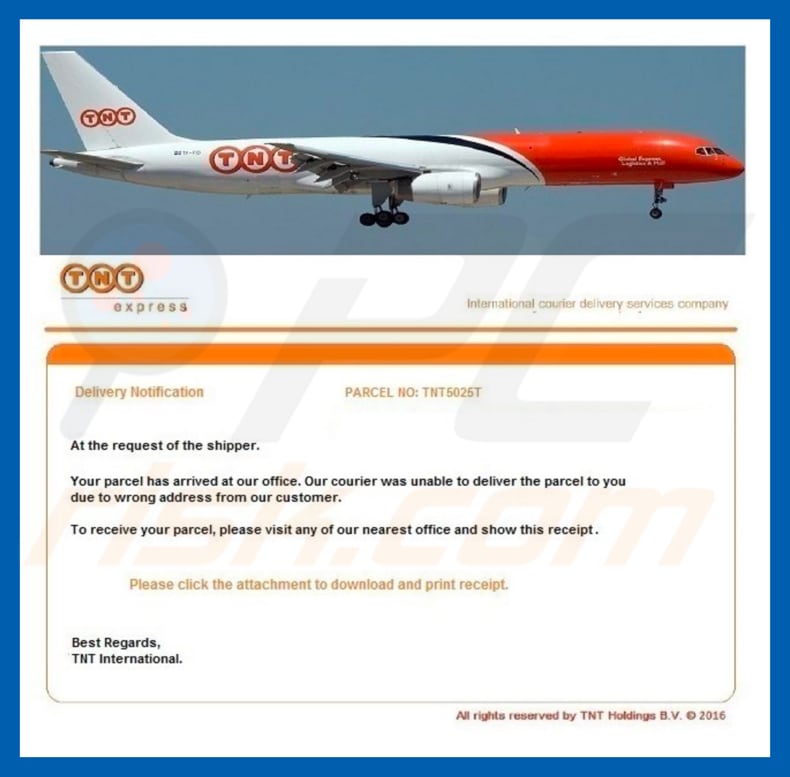
"TNT Email Virus" overview
Scammers send the "TNT Email Virus" email to thousands people. They claim to be team members of TNT (a legitimate international courier delivery services company). This spam campaign is used to trick people into believing that a parcel could not be delivered in person due the wrong address having been supplied.
Recipients are encouraged to click a link that will supposedly download and print a receipt required to receive the parcel. This is a scam used to infect computers with a virus. If clicked, the link downloads a high-risk LokiBot virus designed to record data such as logins and passwords (mostly in web browsers), and tracks users' browsing activity, and so on.
Having a computer infected with this virus might result in various privacy issues or even financial loss. This infection can also be used to proliferate viruses by sending malicious executables to users' contacts lists. If installed, this virus can be identified as a "Delivery Note - AWD (sequence of numbers)" process in Task Manager (see screenshot below).
Do not click the link within the "TNT Email Virus" email - simply ignore this spam email. If, however, you have already clicked it, immediately scan the system with a reputable anti-virus/anti-spyware suite and eliminate all threats.
| Name | TNT spam |
| Threat Type | Trojan, Password stealing virus, Banking malware, Spyware |
| Symptoms | Trojans are designed to stealthily infiltrate victim's computer and remain silent thus no particular symptoms are clearly visible on an infected machine. |
| Distribution methods | Infected email attachments, malicious online advertisements, social engineering, software cracks. |
| Damage | Stolen banking information, passwords, identity theft, victim's computer added to a botnet. |
| Malware Removal (Windows) |
To eliminate possible malware infections, scan your computer with legitimate antivirus software. Our security researchers recommend using Combo Cleaner. Download Combo CleanerTo use full-featured product, you have to purchase a license for Combo Cleaner. 7 days free trial available. Combo Cleaner is owned and operated by RCS LT, the parent company of PCRisk.com. |
Examples of malware delivered via email
There are many spam campaigns used to proliferate high-risk viruses like LokiBot. Examples of other infections are FormBook, Adwind, TrickBot, and AZORult. In most cases, these viruses are designed to steal sensitive information related to logins, passwords, etc., or to spread other infections (such as ransomware).
The data is used by developers to generate revenue. These viruses cause privacy/browsing issues and other similar problems. We strongly recommend that you remove these viruses as soon as possible.
How did "TNT Email Virus" infect my computer?
These spam email campaigns are used to proliferate infections through malicious attachments (or links that download attachments). In this case, "TNT Email Virus" contains a link that leads to download of a malicious file. Once downloaded and opened, this attachment installs the LokiBot virus.
If the attachment is a Microsoft Office document, it asks to enable macros commands (viruses cannot be proliferated unless macros are enabled). If the attachment is an archive file, it must be extracted, and if an executable file, it must be executed, and so on. I.e. users must trigger the infection manually.
How to avoid installation of malware?
To keep your computer safe from infections that are proliferated through email attachments, carefully analyze the email. If an email is received from a suspicious/unknown address, or it seems irrelevant, do not click the link or download the attachment. Have reputable anti-virus/anti-spyware software installed and enabled.
These programs can detect viruses before they can do any harm. Browse the web and install applications with care. Careless behavior and poor knowledge are the main reasons for computer infections. Caution is the key to safety. If you have already opened a "TNT Email Virus" attachment, we recommend running a scan with Combo Cleaner Antivirus for Windows to automatically eliminate infiltrated malware.
Text presented in the "TNT Email Virus" email message:
Subject: TNT | Express Shipping
Delivery Notification PARCEL NO: TNT5025T
At the request of the shipper.
Your parcel has arrived at our office. Our courier was unable to deliver the parcel to you due to wrong adress from our customer.
To receive your parcel, please visit any of our nearest office and show this receipt.
Please click the attachment to download and print receipt.
Best Regards,
TNT InternetionalAll rights reserved by TNT Holdings B.V © 2016
Screenshot of a LokiBot virus process ("Delivery Note - AWD (sequence of numbers)") in Windows Task Manager:
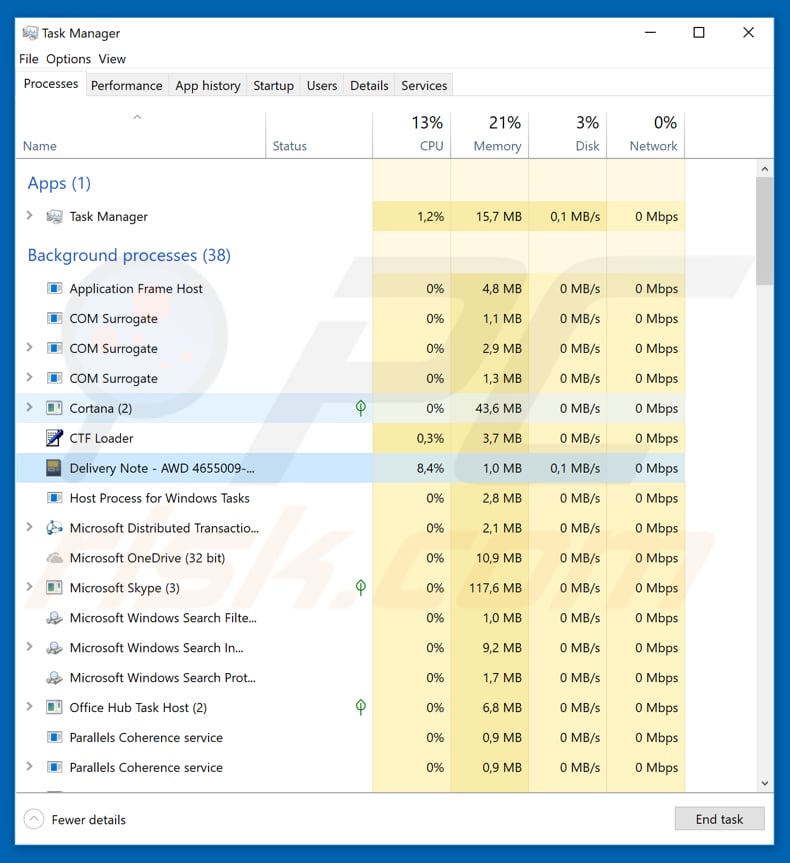
Another variant of TNT spam email:
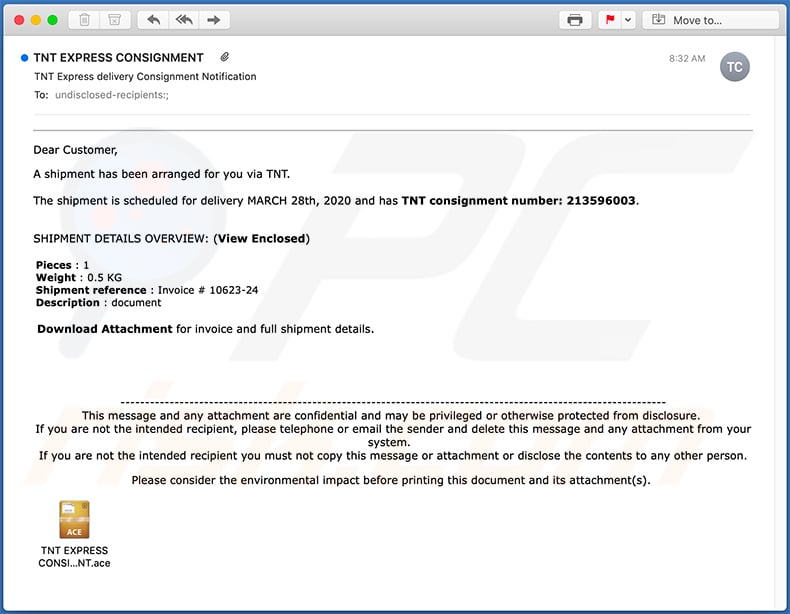
Text presented within this email:
Subject: TNT Express delivery Consignment Notification
Dear Customer,
A shipment has been arranged for you via TNT.
The shipment is scheduled for delivery MARCH 28th, 2020 and has TNT consignment number: 213596003.
SHIPMENT DETAILS OVERVIEW: (View Enclosed)Pieces : 1
Weight : 0.5 KG
Shipment reference : Invoice # 10623-24
Description : document
Download Attachment for invoice and full shipment details.----------
This message and any attachment are confidential and may be privileged or otherwise protected from disclosure.
If you are not the intended recipient, please telephone or email the sender and delete this message and any attachment from your system.
If you are not the intended recipient you must not copy this message or attachment or disclose the contents to any other person.Please consider the environmental impact before printing this document and its attachment(s).
Another example of TNT-themed spam email spreading malware:
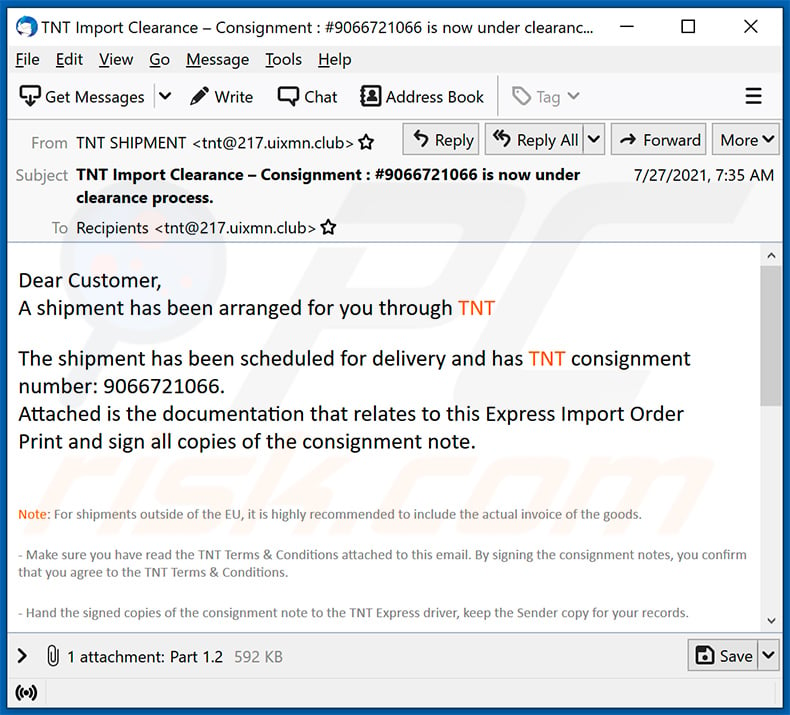
Text presented within:
Subject: TNT Import Clearance – Consignment : #9066721066 is now under clearance process.
Dear Customer,
A shipment has been arranged for you through TNTThe shipment has been scheduled for delivery and has TNT consignment number: 9066721066.
Attached is the documentation that relates to this Express Import Order
Print and sign all copies of the consignment note.Note: For shipments outside of the EU, it is highly recommended to include the actual invoice of the goods.
- Make sure you have read the TNT Terms & Conditions attached to this email. By signing the consignment notes, you confirm that you agree to the TNT Terms & Conditions.
- Hand the signed copies of the consignment note to the TNT Express driver, keep the Sender copy for your records.
- Leave the shipment open for TNT Express driver to inspect.
As your order has been processed automatically, it is not necessary to contact TNT Express Customer Service by telephone.
If you would like to find out about the many ways TNT helps you to track your shipment, or if you would like to know more about the services provided by TNT, simply connect to www.tnt.com and select your location at any time.---------------------------------
This message and any attachment are confidential and may be privileged or otherwise protected from disclosure.
If you are not the intended recipient, please telephone or email the sender and delete this message and any attachment from your system.
If you are not the intended recipient you must not copy this message or attachment or disclose the contents to any other person.
Please consider the environmental impact before printing this document and its attachment(s).
Print black and white and double-sided where possible.
---------------------------------
An example of TNT-themed spam email spreading Agent Tesla malware:
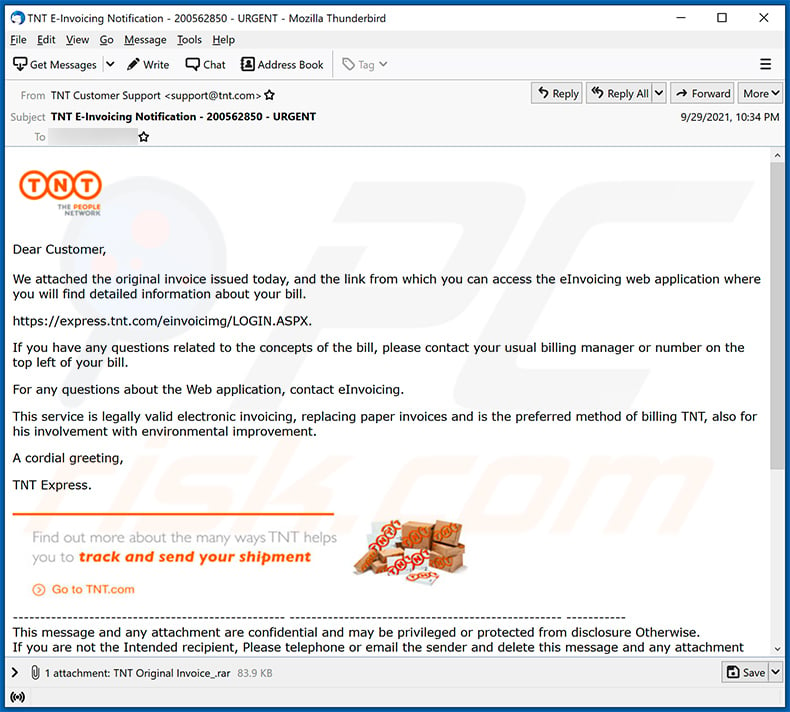
Text presented within:
Subject: TNT E-Invoicing Notification - 200562850 - URGENT
Dear Customer,
We attached the original invoice issued today, and the link from which you can access the eInvoicing web application where you will find detailed information about your bill.
hxxps://express.tnt.com/einvoicimg/LOGIN.ASPX.
If you have any questions related to the concepts of the bill, please contact your usual billing manager or number on the top left of your bill.
For any questions about the Web application, contact eInvoicing.
This service is legally valid electronic invoicing, replacing paper invoices and is the preferred method of billing TNT, also for his involvement with environmental improvement.
A cordial greeting,
TNT Express.
Instant automatic malware removal:
Manual threat removal might be a lengthy and complicated process that requires advanced IT skills. Combo Cleaner is a professional automatic malware removal tool that is recommended to get rid of malware. Download it by clicking the button below:
DOWNLOAD Combo CleanerBy downloading any software listed on this website you agree to our Privacy Policy and Terms of Use. To use full-featured product, you have to purchase a license for Combo Cleaner. 7 days free trial available. Combo Cleaner is owned and operated by RCS LT, the parent company of PCRisk.com.
Quick menu:
- What is TNT spam?
- Types of malicious emails.
- How to spot a malicious email?
- What to do if you fell for an email scam?
Types of malicious emails:
![]() Phishing Emails
Phishing Emails
Most commonly, cybercriminals use deceptive emails to trick Internet users into giving away their sensitive private information, for example, login information for various online services, email accounts, or online banking information.
Such attacks are called phishing. In a phishing attack, cybercriminals usually send an email message with some popular service logo (for example, Microsoft, DHL, Amazon, Netflix), create urgency (wrong shipping address, expired password, etc.), and place a link which they hope their potential victims will click on.
After clicking the link presented in such email message, victims are redirected to a fake website that looks identical or extremely similar to the original one. Victims are then asked to enter their password, credit card details, or some other information that gets stolen by cybercriminals.
![]() Emails with Malicious Attachments
Emails with Malicious Attachments
Another popular attack vector is email spam with malicious attachments that infect users' computers with malware. Malicious attachments usually carry trojans that are capable of stealing passwords, banking information, and other sensitive information.
In such attacks, cybercriminals' main goal is to trick their potential victims into opening an infected email attachment. To achieve this goal, email messages usually talk about recently received invoices, faxes, or voice messages.
If a potential victim falls for the lure and opens the attachment, their computers get infected, and cybercriminals can collect a lot of sensitive information.
While it's a more complicated method to steal personal information (spam filters and antivirus programs usually detect such attempts), if successful, cybercriminals can get a much wider array of data and can collect information for a long period of time.
![]() Sextortion Emails
Sextortion Emails
This is a type of phishing. In this case, users receive an email claiming that a cybercriminal could access the webcam of the potential victim and has a video recording of one's masturbation.
To get rid of the video, victims are asked to pay a ransom (usually using Bitcoin or another cryptocurrency). Nevertheless, all of these claims are false - users who receive such emails should ignore and delete them.
How to spot a malicious email?
While cyber criminals try to make their lure emails look trustworthy, here are some things that you should look for when trying to spot a phishing email:
- Check the sender's ("from") email address: Hover your mouse over the "from" address and check if it's legitimate. For example, if you received an email from Microsoft, be sure to check if the email address is @microsoft.com and not something suspicious like @m1crosoft.com, @microsfot.com, @account-security-noreply.com, etc.
- Check for generic greetings: If the greeting in the email is "Dear user", "Dear @youremail.com", "Dear valued customer", this should raise suspiciousness. Most commonly, companies call you by your name. Lack of this information could signal a phishing attempt.
- Check the links in the email: Hover your mouse over the link presented in the email, if the link that appears seems suspicious, don't click it. For example, if you received an email from Microsoft and the link in the email shows that it will go to firebasestorage.googleapis.com/v0... you shouldn't trust it. It's best not to click any links in the emails but to visit the company website that sent you the email in the first place.
- Don't blindly trust email attachments: Most commonly, legitimate companies will ask you to log in to their website and to view any documents there; if you received an email with an attachment, it's a good idea to scan it with an antivirus application. Infected email attachments are a common attack vector used by cybercriminals.
To minimise the risk of opening phishing and malicious emails we recommend using Combo Cleaner Antivirus for Windows.
Example of a spam email:

What to do if you fell for an email scam?
- If you clicked on a link in a phishing email and entered your password - be sure to change your password as soon as possible. Usually, cybercriminals collect stolen credentials and then sell them to other groups that use them for malicious purposes. If you change your password in a timely manner, there's a chance that criminals won't have enough time to do any damage.
- If you entered your credit card information - contact your bank as soon as possible and explain the situation. There's a good chance that you will need to cancel your compromised credit card and get a new one.
- If you see any signs of identity theft - you should immediately contact the Federal Trade Commission. This institution will collect information about your situation and create a personal recovery plan.
- If you opened a malicious attachment - your computer is probably infected, you should scan it with a reputable antivirus application. For this purpose, we recommend using Combo Cleaner Antivirus for Windows.
- Help other Internet users - report phishing emails to Anti-Phishing Working Group, FBI’s Internet Crime Complaint Center, National Fraud Information Center and U.S. Department of Justice.
Frequently Asked Questions (FAQ)
Why did I receive this email?
Emails containing malicious files or links usually are non-targeted. All recipients receive the same letter.
I have downloaded and opened a file attached to this email, is my computer infected?
It is known that cybercriminals behind TNT-themed emails attach archive files like .ace and .rar. Opening archive files that contain malware does not infect computers. However, executing their contents can (depending on the type of compressed files). If you have opened an executable file, your computer is probably infected.
I have read the email but did not open the attachment, is my computer infected?
It is safe to open emails that contain malicious attachments or links. Computers cannot be infected via emails without opening their contents.
Will Combo Cleaner remove malware infections that were present in email attachment?
Yes, Combo Cleaner will scan the operating system for threats and remove them. This application can detect almost all known malware. It is important to know that high-end malware can hide deep in the system. Thus, computers infected with such malware should be scanned using a full scan.
Share:

Tomas Meskauskas
Expert security researcher, professional malware analyst
I am passionate about computer security and technology. I have an experience of over 10 years working in various companies related to computer technical issue solving and Internet security. I have been working as an author and editor for pcrisk.com since 2010. Follow me on Twitter and LinkedIn to stay informed about the latest online security threats.
PCrisk security portal is brought by a company RCS LT.
Joined forces of security researchers help educate computer users about the latest online security threats. More information about the company RCS LT.
Our malware removal guides are free. However, if you want to support us you can send us a donation.
DonatePCrisk security portal is brought by a company RCS LT.
Joined forces of security researchers help educate computer users about the latest online security threats. More information about the company RCS LT.
Our malware removal guides are free. However, if you want to support us you can send us a donation.
Donate
▼ Show Discussion